NASA Payloads for (Task Order) TO20A (VIPER) – Astrobotic Technology Griffin Lander
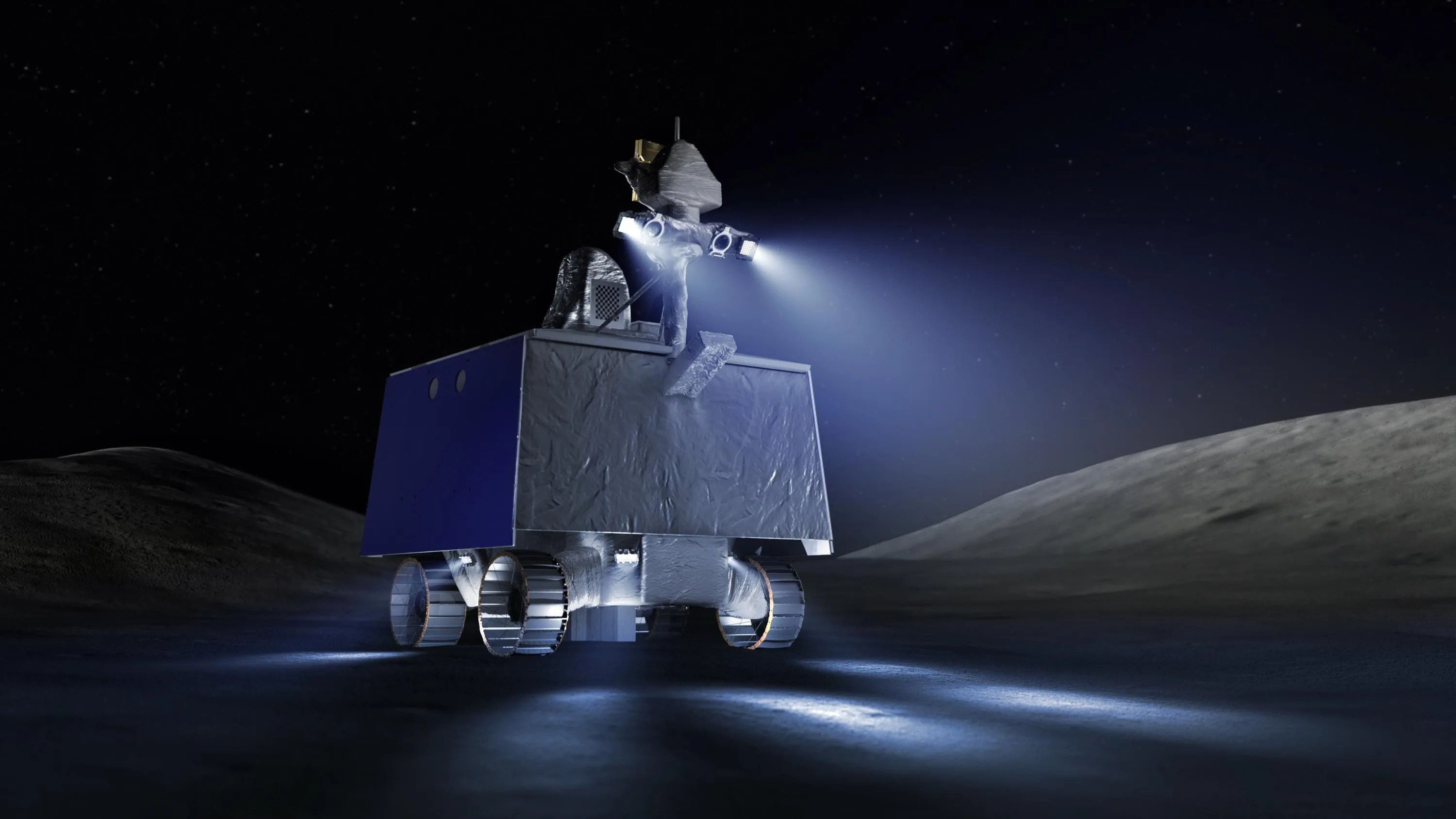
Artist's concept of NASA’s VIPER, which will gather information on the location and concentration of volatiles (e.g. water ice) and other resources at the Moon's South Pole, bringing us closer to agency goals of a greater presence on the Moon as well as exploring Mars and beyond.
NASA / Daniel Rutter
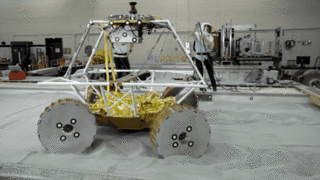
An engineering model of the Volatiles Investigating Polar Exploration Rover, or VIPER, is tested in the Simulated Lunar Operations Laboratory at NASA’s Glenn Research Center in Cleveland, Ohio. The test helped evaluate qualities like the traction of the wheels on the Moon's surface and, here, shows a swimming-like motion capable of pulling the rover out of very soft soils.
NASA / Alcyon Technical Services/ James Zunt
- Summary: The Volatiles Investigation Polar Exploration Rover (VIPER) is a lunar polar volatiles prospecting mission developed through NASA’s Science Mission Directorate (SMD) Planetary Science Division with launch in late 2024. The mission includes a rover-borne payload that (1) can locate surface and near-subsurface volatiles, (2) excavate and analyze samples of the volatile-bearing regolith, and (3) demonstrate the form, extractability, and usefulness of the materials. VIPER’s primary mission goal is to characterize the distribution of water and volatiles across a range of thermal environments. This characterization will assist in understanding the origin of lunar polar volatiles and help evaluate the In-Situ Resource Utilization (ISRU) potential of the lunar poles. VIPER will be optimized for lunar regions that receive prolonged periods of sunlight (short lunar nights); prospectively, the mission duration will be more than 100 Earth days, and result in a traverse distance of 20 or more km. For more information on this mission, visit the NASA’s dedicated VIPER site.
- It has headlights, so it can offer us insight into dark places and dark craters that are permanently shadowed. It is the first NASA rover with headlights. This little rover can move sideways, in circles, and basically any direction for maximum mobility. VIPER's camera system will allow operators on Earth to visualize the terrain the rover needs to navigate and send commands in near-real time based on what they see – where and how fast to move, and where to stop and search for water ice. Typically, the operators will tell the rover to move between 12 and 25 feet (4 to 8 meters), before downlinking data and reassessing. VIPER will send its science and prospecting data back using an X-band communications system that connects directly with Earth over the Deep Space Network
- Instruments Included: Neutron Spectrometer System (NSS), Near InfraRed Volatiles Spectrometer System (NIRVSS), Mass Spectrometer. Observing Lunar Operations (MSolo), The Regolith and Ice Drill for Exploring New Terrains (TRIDENT) Drill
- Type of Instrument: Rover
- Key Measurements: Surface and subsurface volatiles (i.e., things that evaporate or sublimate easily)
- Task Order: CLPS TO 20A (VIPER)
- Lead Development Organization: ARC
- Payload PI: Dr. Anthony Colaprete
Neutron Spectrometer System (NSS)
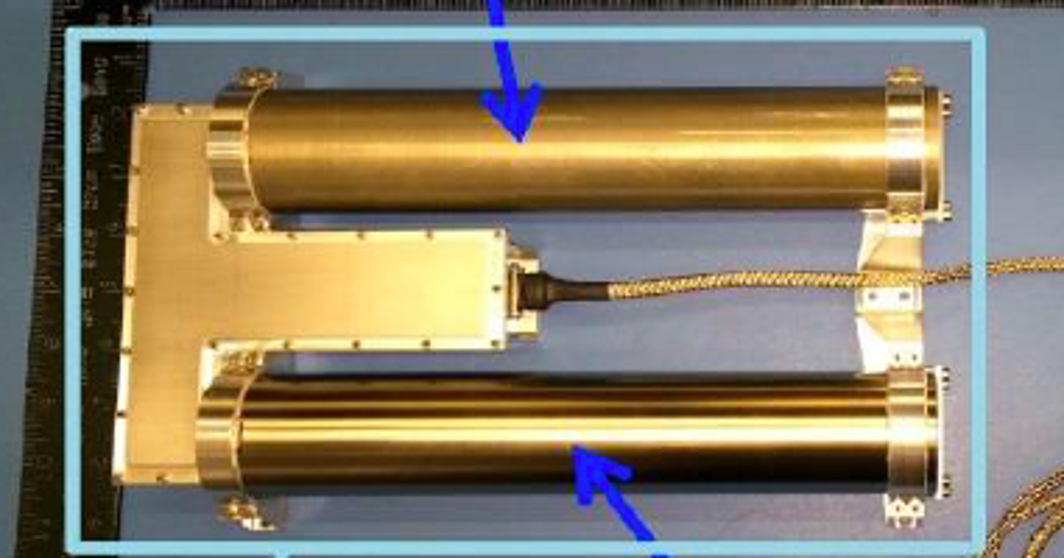
The Neutron Measurements at the Lunar Surface (NLMS) will consist of a neutron spectrometer [JC[1] that will measure thermal and epithermal neutron [JC[2] count rates. This instrument is a redesign of the Fast Neutron Spectrometer that has been on the International Space Station. NLMS is being developed at the Marshall Space Flight Center in Huntsville, Alabama.
NASA / MSFC
- Summary: Prospects for hydrogen-rich materials while roving, mapping for the distributions. This instrument will determine the abundance of hydrogen-bearing materials along the rover traverse. NSS can measure the total volume of hydrogen up to three feet below the surface. This is better than just detecting the amount of hydrogen from orbit because this gives us a more accurate reading on the presence of subsurface at very small spatial scales. NSS uses radiation to make its measurements. NSS measures the number and energy of neutrons present as radiation on the Moon, which can be used to infer the amount of hydrogen present in the soil. This detection is possible because when neutrons strike a hydrogen atom, they lose a lot of energy.
- Type of Instrument: Two Channel Neutron Spectrometer
- Key Measurement: NSS Assesses Hydrogen and bulk composition in the top meter of the regolith, measuring down to 0.5% (wt) WEH while roving
- Task Order: CLPS TO 20A (VIPER)
- Lead Development Organization: (NASA ARC, Lockheed Martin ATC)
- Payload PI: Dr. Rick Elphic (NASA ARC)
Note: See also TO2-AB
Near InfraRed Volatiles Spectrometer System (NIRVSS)
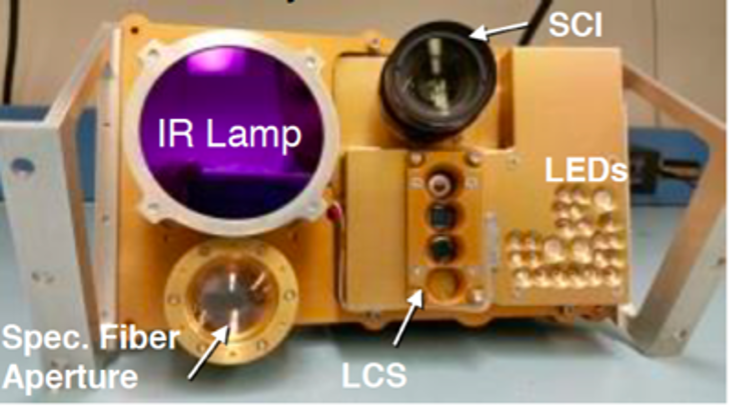
NIRVSS will measure surface and subsurface hydration on the Moon. These measurements can be taken while the instrument is moving.
NASA / JSC
- Summary: Prospects for surface water “frosts” and evaluates excavated materials. The payload includes a spectrometer, context imager and a thermal radiometer. It measures surface and subsurface hydration (H2O and OH) and other volatiles, including, for example, CO2 and CH4, while simultaneously mapping surface morphology and surface temperature. The plan is for the measurements to take place during rover traverse, throughout areas of targeted volatile investigation (called science stations), and during drilling activities. This instrument was created at NASA Ames Research Center. In total, it has three specific instruments: the near-infrared spectrometer, Ames imaging module, and a thermal radiometer, known as the longwave calibration sensor. To work in shadowed regions NIRVSS carries with it a lamp and seven different colored LEDs which will be used to illuminate the surface when in the dark.
- Type of Instrument: NIR Point Spectrometer, 4 Mpxl Panchromatic Imager with 7 LEDs, 4-ch thermal radiometer
- Key Measurement: Volatiles including H2O, OH, and CO2 and mineralogy, surface morphology/temps
- Task Order: CLPS TO20A (VIPER)
- Lead Development Organization: NASA ARC / Brimrose Corporation
- Payload PI: Dr. Anthony Colaprete
Note: See also TO2-AB
Mass Spectrometer Observing Lunar Operations (MSolo)
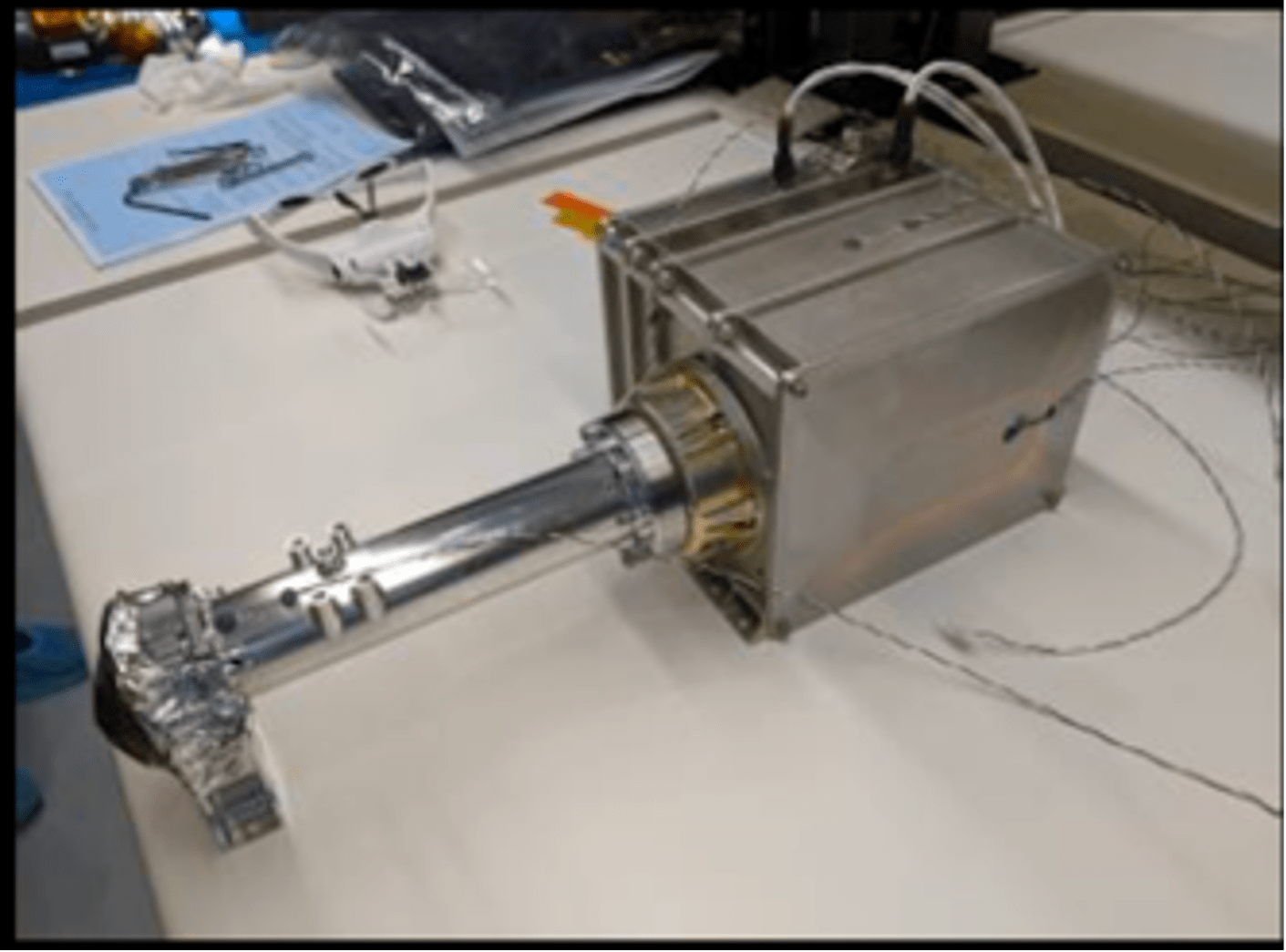
This instrument will allow identification of low-molecular-weight volatiles, it’s named the Mass Spectrometer observing lunar operations (MSolo). Some things that MSolo aims to study is classifying different molecules in the exosphere and collect information on possible formation of those volatiles. It is under construction at the Kennedy Space Center, located in Florida.
NASA
- Summary: Prospects for surface volatiles while traversing and during drilling. MSolo will identify low-molecular-weight volatiles with unit mass resolution to measure isotopes including D/H and O18/O16. In other words, it will identify molecules coming off the surface or out of subsurface samples, including possible water. MSolo will be making these measurements while the rover is driving, sensing gasses that might be released from the lunar soil by the rover wheels, and while the mission is drilling, measuring gasses come out of subsurface samples.
- Type of Instrument: Quadrupole mass spectrometer
- Key Measurement: Identifying low-molecular weight volatiles between 1-100 amu, unit mass resolution to measure isotopes including D/H and O18/O16
- Task Order: CLPS TO 20A (VIPER)
- Lead Development Organization: (KSC, INFICON)
- Payload PI: Dr. Janine Captain, Dr. Jackie Quinn
Note: See also TO2-AB and PRIME-1
The Regolith and Ice Drill for Exploring New Terrains (TRIDENT )
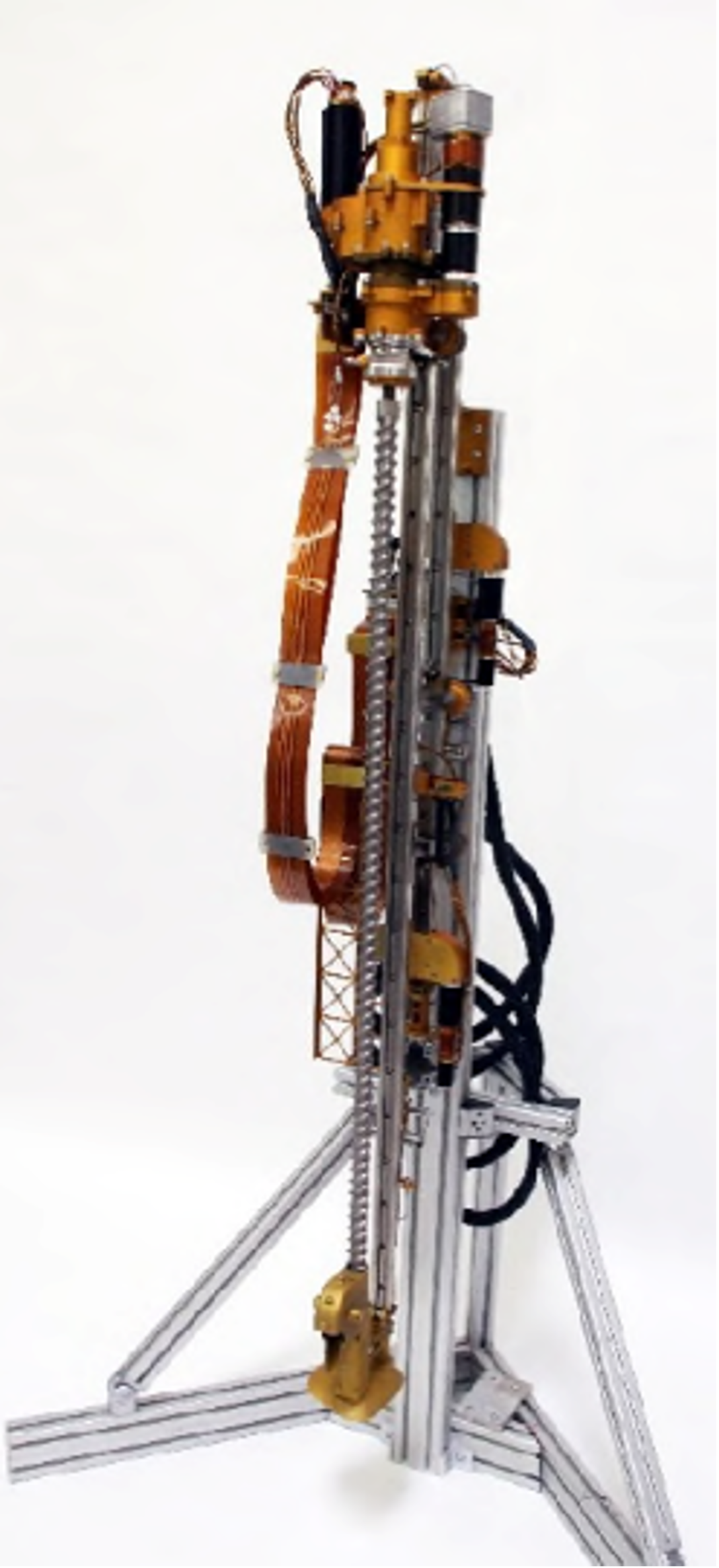
This 1-meter hammer drill is named The Regolith and Ice Drill for Exploring New Terrains (TRIDENT). It will provide researchers the opportunity to collect lunar surface samples that are about 10 cm in length to then be analyzed by other VIPER instruments.
NASA / KSC
- Summary: Excavates lunar regolith and subsurface material to 1-meter deep (3.3 feet) and measures forces, displacements, and temperatures for regolith bulk properties. This brings samples to the surface where other VIPER instruments (NIRVSS and MSolo) can inspect them for the presence of water and other volatiles. Most samples will be about 10 cm in length giving ten samples across the entire 1-meter drill hole. We were able to use a drill like this on Apollo 15, and this will help us maintain longer missions in the future. TRIDENT is a rotary percussive drill, but unlike its ancestor, it does not require human operation. It weighs 16 kg (35 pounds) and should be capable of digging a hole 1-meter deep (3.3 feet) in 10 cm (4 inch) bites. This approach allows for a more accurate determination of how deep substances of interest can be found in the soil. The drill bit at the tip has carbide cutting teeth. These are harder than steel to maintain their sharpness, and strong enough to drill into basalt if needed.
- Type of Instrument: 1-meter Hammer drill
- Key Measurement: Excavation of sub-surface material; measuring forces, displacements, and temperatures for regolith bulk properties (e.g., subsurface temperature vs. depth; strength of regolith vs. depth)
- Task Order: CLPS TO20A (VIPER)
- Lead Development Organization: Honeybee Robotics
- Payload PI: Dr. Kris Zacny (Honeybee)
Note: See also CLPS TO PRIME-1
Laser Retroreflector (LRA)
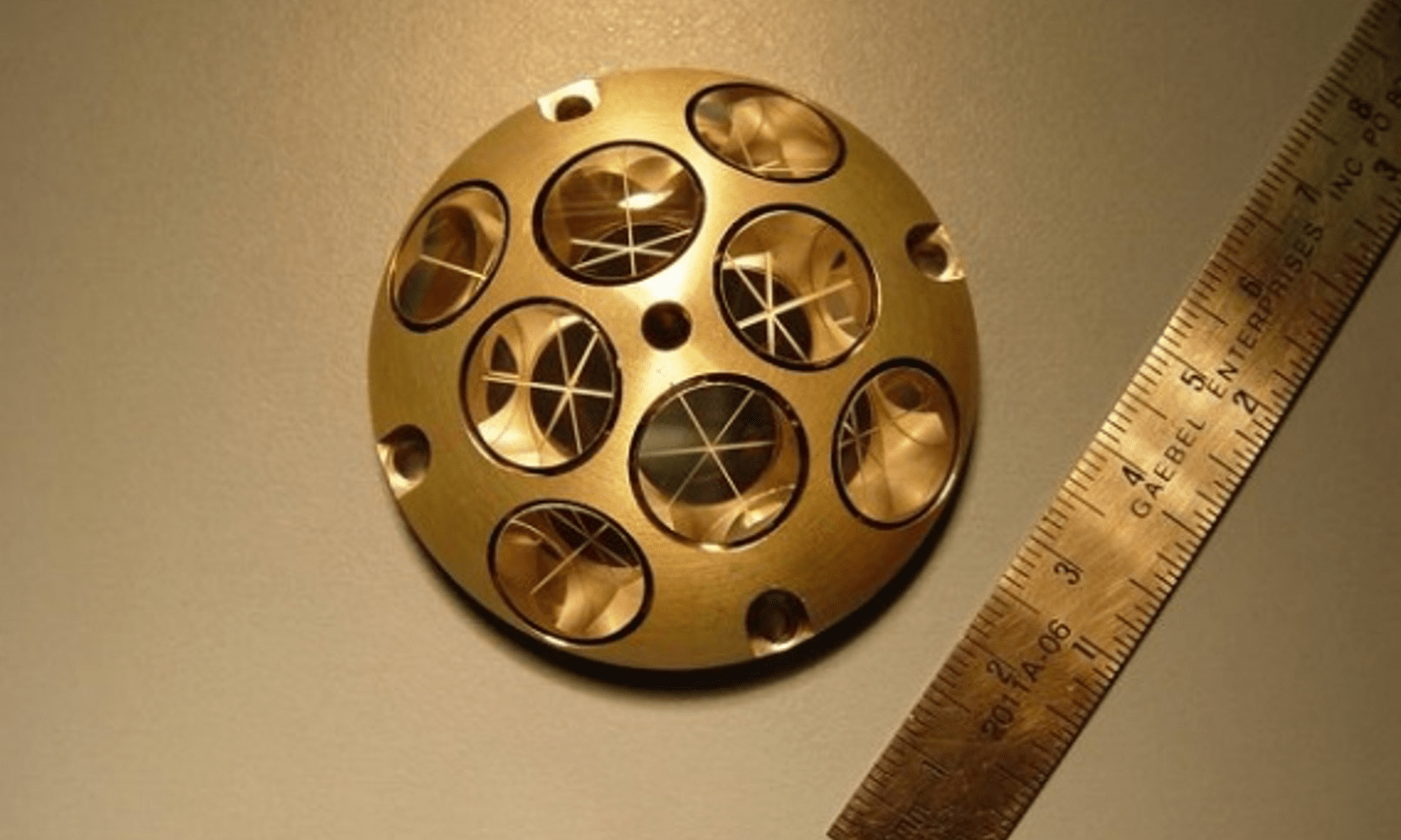
This generated image shows how the LRA will be located on the surface of the Moon so orbiting spacecraft can retroreflect to find a precise distance.
NASA / GSFC
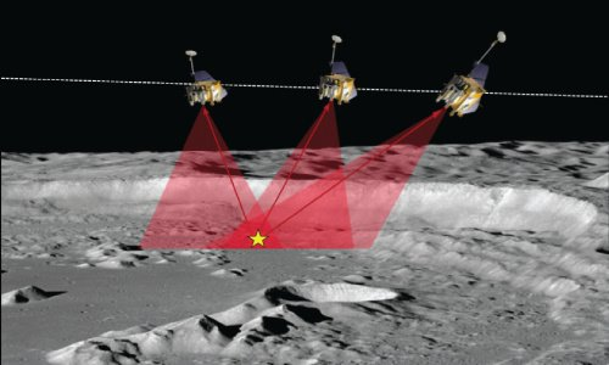
This diagram shows the concept of the lunar navigation satellite will work. The MAPS algorithms are shown in the black and white lined arrows while GPS signaling is shown in the squiggly red and black arrows.
NASA / MSFC
- Summary: A retroreflector bounces any light that shines on it directly backward (180 degrees from the incoming light). The LRA is a collection of eight of these, each a 1.25-cm diameter glass corner cube prism, all embedded in an aluminum hemisphere (painted gold as shown here) and is mounted to the lander deck. This design ensures that the LRA can retroreflect (i.e., bounce) laser light from other orbiting and landing spacecraft over a wide range of incoming directions and efficiently retroreflect the laser signal directly back at the originating spacecraft. This enables precision laser ranging, which is a measurement of the distance between the orbiting or landing spacecraft to the LRA on the lander. The LRA is a passive optical instrument and will function as a permanent fiducial (i.e., location) marker on the Moon for decades to come. (Note: this LRA design is too small for laser ranging from Earth).
- Type of Instrument: Passive optical device that reflects laser light directly backward (for laser ranging)
- Key Measurement: Precise distances
- Task Order: CLPS TO20A (VIPER)
- Lead Development Organization: NASA GSFC
- Payload PI: Dr. Xiaoli Sun
Note: See also TO2-AB, TO2-IM, and PRIME-1
Keep Exploring




